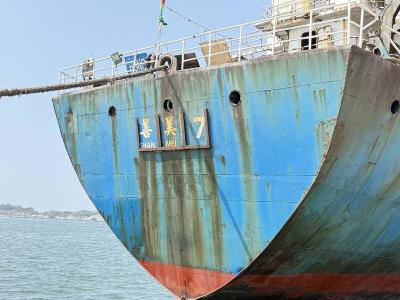The Ministry of Transportation and Communications (MOTC) is looking to revise regulations so that Taiwan-registered cargo or passenger vessels can sail to China from a third country or vice versa, following the opening of direct sailing links across the Taiwan Strait, ministry sources said yesterday.
Cargo vessels had been prohibited from sailing directly between Taiwan and China — except between offshore shipping centers in Kaohsiung, Fuzhou and Xiamen — until the end of last year. That changed when an agreement between Taiwan and China reached in November allowed ships registered in the two countries to sail direct cross-strait routes, beginning on Dec. 15.
Despite the agreement, however, Taiwan-registered vessels have not been able to sail between a third country and China, complicating efforts of shipping companies to arrange efficient routes, ministry officials said.
The ministry’s planned revision of the regulations would allow Taiwanese ships to sail directly from places like Australia or Southeast Asia to China, rather than having to first transit through Taiwan.
Chinese ships would also enjoy the same convenience once the rules are changed, the officials said. The revisions would apply to both cargo vessels and passenger ships, although cargo shipping companies are expected to be the biggest beneficiaries.
Ministry officials said Chinese authorities had already informally agreed to the revision.
Under the revised regulations, the ministry would have the right to take factors such as market demand and transportation needs into consideration when reviewing proposals by eligible companies to sail between a third country to Taiwan or China, the officials said.
The proposal will be discussed internally at the ministry before being submitted to the Executive Yuan for approval, the ministry said.
In related news, Taiwan and China will hold bilateral talks this week on allowing individual Chinese tourists to visit Taiwan.
At present, Chinese tourists must visit Taiwan in groups of at least five people.
Minister of Transportation and Communications Mao Chi-kuo (毛治國) said officials from the Taipei-based Taiwan Strait Tourism and Travel Association and China’s Cross-Strait Tourism Association will meet on Friday to discuss the matter.
Mao said Taiwan raised the issue with China at the request of local small business owners, who said that allowing individual travelers from China would help them earn more tourist dollars. However, Mao said that even if there were a change in policy, the daily ceiling on Chinese visitors to Taiwan would remain at 3,000 through the second half of the year to ensure tourism service quality.
Although the number of coming Chinese visitors rose for the May 1 holiday, the Tourism Bureau forecast that an average of 2,300 Chinese would enter Taiwan every day over the next week.
“Some 3,000 Chinese tourists per day is a level that Taiwan can sustain at present and the quota will gradually increase depending on the market situation to ensure the tourism sector’s long-term development,” he said.
President Ma Ying-jeou (馬英九) expressed concern on Friday that without proper management of the tourism sector, tourism quality would suffer, reducing the willingness of foreigners to visit Taiwan.
In response, Mao said an online monitoring network assessing the number of tourists at major scenic spots across the country would be established to provide travel agencies and tour guides with information in advance and help them better arrange itineraries to avoid overcrowding.

An undersea cable to Penghu County has been severed, the Ministry of Digital Affairs said today, with a Chinese-funded ship suspected of being responsible. It comes just a month after a Chinese ship was suspected of severing an undersea cable north of Keelung Harbor. The National Communications and Cyber Security Center received a report at 3:03am today from Chunghwa Telecom that the No. 3 cable from Taiwan to Penghu was severed 14.7km off the coast of Tainan, the Ministry of Digital Affairs said. The Coast Guard Administration (CGA) upon receiving a report from Chunghwa Telecom began to monitor the Togolese-flagged Hong Tai (宏泰)

A cat named Mikan (蜜柑) has brought in revenue of more than NT$10 million (US$305,390) for the Kaohsiung MRT last year. Mikan, born on April 4, 2020, was a stray cat before being adopted by personnel of Kaohsiung MRT’s Ciaotou Sugar Refinery Station. Mikan was named after a Japanese term for mandarin orange due to his color and because he looks like an orange when curled up. He was named “station master” of Ciaotou Sugar Refinery Station in September 2020, and has since become famous. With Kaohsiung MRT’s branding, along with the release of a set of cultural and creative products, station master Mikan

RISING TOURISM: A survey showed that tourist visits increased by 35 percent last year, while newly created attractions contributed almost half of the growth Changhua County’s Lukang Old Street (鹿港老街) and its surrounding historical area clinched first place among Taiwan’s most successful tourist attractions last year, while no location in eastern Taiwan achieved a spot in the top 20 list, the Tourism Administration said. The listing was created by the Tourism Administration’s Forward-looking Tourism Policy Research office. Last year, the Lukang Old Street and its surrounding area had 17.3 million visitors, more than the 16 million visitors for the Wenhua Road Night Market (文化路夜市) in Chiayi City and 14.5 million visitors at Tainan’s Anping (安平) historical area, it said. The Taipei 101 skyscraper and its environs —

Taiwan on Friday said a New Zealand hamburger restaurant has apologized for a racist remark to a Taiwanese customer after reports that it had first apologized to China sparked outrage in Taiwan. An image posted on Threads by a Taiwanese who ate at Fergburger in Queenstown showed that their receipt dated Sunday last week included the words “Ching Chang,” a racial slur. The Chinese Consulate-General in Christchurch in a statement on Thursday said it had received and accepted an apology from the restaurant over the incident. The comment triggered an online furor among Taiwanese who saw it as an insult to the